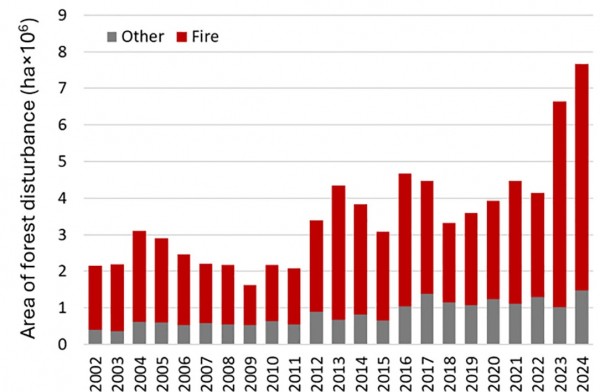Forest Loss Caused by Wildfires Has Reached Record Levels in 2023 and 2024
New data from UMD’s GLAD Lab shows fires now account for more than 40% of global forest disturbance, up sharply from past decades.
Forest loss caused by wildfires reached record levels in 2023 and 2024, according to data from the Global Land Analysis and Discovery (GLAD) Laboratory. The study, led by Research Professor Peter Potapov at the Department of Geographical Sciences, was published in the journal Proceedings of the National Academy of Sciences. An estimated 36.6 million hectares of forest were disturbed by fire in 2023, followed by 38.3 million hectares in 2024. These are the highest totals recorded since global satellite monitoring began in 2001.
Fires accounted for 42% of all forest disturbance during those two years, a sharp rise from the 26% to 29% recorded between 2001 and 2019. Researchers found a statistically significant global increase in fire-related forest disturbance from 2002 to 2024, with the exception of subtropical regions.
Compared to the 2002–2022 average, the 2023–2024 annual average of fire-related forest disturbance was 2.2 times higher globally. The largest increases occurred in tropical forests, where fire disturbance tripled, and in boreal forests, where it more than doubled. In major fire years such as 2016 and 2024, more than a quarter of all fire-related forest loss occurred in the Tropics.
At the continental level, North America experienced the sharpest increase, with fire-related forest disturbance rising 3.7 times over the previous two decades. Latin America followed with a 3.4-fold increase, and Africa with a 2.4-fold increase. Statistically significant upward trends were also found in Eurasia.
The top 10 countries with the largest increases between the two time periods include Canada, Russia, Brazil, Bolivia, Mexico, the Democratic Republic of the Congo, Guatemala, Guyana, Peru and Greece.
Researchers say the overall rise in forest disturbance is being driven largely by wildfires. Between the 2002–2022 and 2023–2024 periods, the average annual area disturbed by fire more than doubled, while disturbance from other causes increased by just 20%. In boreal forests, fire accounted for 86% of total disturbance, up from 73%. In tropical rainforests, it rose from 8% to 19%.
“The unprecedented scale of fires in the world’s most remote forests is a potential harbinger of ecosystem tipping points,” the researchers wrote. The years 2023 and 2024 were also the hottest on record globally since 1850, with extreme heat contributing to the surge in wildfires.
Particularly concerning is the rise in fire activity within intact forest landscapes, which hold exceptional biodiversity and carbon storage. Fire-related disturbance in these forests was 2.5 times higher in 2023 and 2024 than the 2002–2022 average, with a statistically significant upward trend.
“The article highlights an alarming trend of increasing forest fire frequency in undisturbed tropical rainforests, likely linked to increased forest fragmentation from expanding human activities and to the effects of climate change,” said Alexandra Tyukavina, associate research professor at the Department of Geographical Sciences and co-author of the study.
Satellite data from the Visible Infrared Imaging Radiometer Suite (VIIRS) supports these findings. In August 2024, active fire detections were 25% higher than any previous August since 2012. For the year overall, detections were 14% higher than the 2012–2022 average for all forests—and 121% higher for intact forest landscapes. Monthly fire activity also showed a statistically significant increase in these critical ecosystems.
“Unprecedentedly high global forest disturbance due to fire in 2023 and 2024.” Peter Potapov, Alexandra Tyukavina, Svetlana Turubanova, Matthew C. Hansen, Louis Giglio, Andres Hernandez-Serna, André Lima, Nancy Harris, Fred Stolle. Proceedings of the National Academy of Sciences of the USA (PNAS), July 21, 2025
122 (30) e2505418122 https://doi.org/10.1073/pnas.2505418122
Main Image: Annual area of forest disturbance due to fire and other proximate causes within Intact Forest Landscapes (IFL), 2002 to 2024.. Courtesy of Peter Potapov.
Related Articles
Pulling the Global Fire Alarm
GLAD Produces Data for Global Forests Report Featured in The New York Times, BBC
Climate Change Is Making Fire Weather Worse for World’s Forests [The New York Times]
Published on Mon, 07/21/2025 - 15:30


